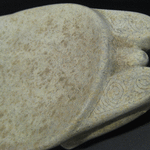Taino Stone Zemi Metate (Duho), 1200 CE - 1500 CE
Stone
15.5 x 3
BF.002
The Taino flourished in the Caribbean c.120 -1500 and had an incredibly sophisticated visual culture. Today, they are best remembered for their stone carving, especially the unusual triangular ritual objects,...
The Taino flourished in the Caribbean c.120 -1500 and had an incredibly sophisticated visual culture. Today, they are best remembered for their stone carving, especially the unusual triangular ritual objects, known as three-pointers. Despite the predominance of stone amongst surviving pieces, they also worked in clay, wood and shell. This shallow dish-like object is carved from a pale grey stone. It depicts a zemi (Taino deity) lying on its back, facing the sky. The arms and legs are bent beneath the body and support the flat surface above. The zemi’s facial features are skull-like with round eye-sockets and a wide jaw. Despite minor damage, the design of the headdress is still impressive. Complex geometric designs are a recurring feature in Taino art and may once have had a cosmological significance that is difficult to reconstruct today.
There are several possibilities as to the function of this piece. The form is closely related to that of the duho- Taino seats that were used at important ceremonies, such as the ball-games or during cohoba rituals. These often had high-backs but some flat examples in stone are known. The majority of duhos were carved in wood and c.100 examples survive. Their production and distribution were controlled by the Taino chieftains (caciques) and only those of the highest rank were permitted to use them. The second possibility is that this is a metate, i.e. a grinding surface for grain, seeds or the hallucinogenic cohoba. Metates were common throughout the Pre-Columbian world; the most well-known examples come from Costa Rica and were fashioned from volcanic stone. Given the time and effort expended on the carving of this example, it is unlikely to have been used for everyday food preparation. The most convincing interpretation is that it was part of the elaborate paraphernalia, including pestles, amulets and zemi-sculptures, employed during cohoba ceremonies. Taino religious leaders, or shamans, were thought to be able to communicate with the dead after entering a trance-like state. This is an exceptional and rare Taino artifact that will appeal to any ambitious collector of Pre- Columbian art. (AM)
There are several possibilities as to the function of this piece. The form is closely related to that of the duho- Taino seats that were used at important ceremonies, such as the ball-games or during cohoba rituals. These often had high-backs but some flat examples in stone are known. The majority of duhos were carved in wood and c.100 examples survive. Their production and distribution were controlled by the Taino chieftains (caciques) and only those of the highest rank were permitted to use them. The second possibility is that this is a metate, i.e. a grinding surface for grain, seeds or the hallucinogenic cohoba. Metates were common throughout the Pre-Columbian world; the most well-known examples come from Costa Rica and were fashioned from volcanic stone. Given the time and effort expended on the carving of this example, it is unlikely to have been used for everyday food preparation. The most convincing interpretation is that it was part of the elaborate paraphernalia, including pestles, amulets and zemi-sculptures, employed during cohoba ceremonies. Taino religious leaders, or shamans, were thought to be able to communicate with the dead after entering a trance-like state. This is an exceptional and rare Taino artifact that will appeal to any ambitious collector of Pre- Columbian art. (AM)



